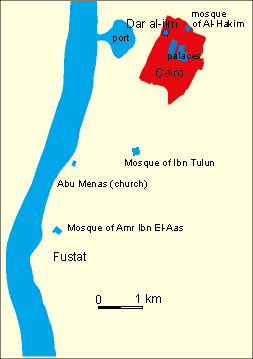Objects and knowledge in Egypt 4th-19th centuries AD
The object in Christian Egypt
The treasury and library of church and monastery may provide parallels to the
earlier institutions of object and knowledge. The focus falls now on the more
heavily ornamented objects used in the liturgy, and on the collections of books.
The emphasis on a sacred book, the Bible, gives Christianity the same intense
focus on the written word as object, as is found in the other 'religions of
the Book', Judaism and Islam. In Egypt, the major difference between Christian
institutions and those of earlier times lies in the relations of power: in contrast
to other periods and faiths, Christian Egypt never had its own resident ruler.
Even the Byzantine Emperors ruling Egypt from the fourth to seventh centuries
AD were Orthodox Christian, regarding the Monophysite Christianity of Egypt
as a heresy. With the patronage of that Christian state concentrated outside
Egypt, on the imperial capital Byzantium (present-day Istanbul), there would
have been less opportunity for accumulating extensive treasuries of culturally
valued objects. However, the Christian Egyptian attitude to the single object
and to collections of objects remains to be researched.
Institutions of knowledge in Islamic Egypt
Islam projects itself consciously as a quest, and has therefore always cultivated
and promoted institutions of knowledge, learning and teaching. The largest branch
of Islam, Sunni Islam, maintains its teachings through the institution of the
madrasa 'school', and many of the most famous buildings of medieval Cairo include
the magnificent architectural setting for these institutions of learning. Today
the mosque of al-Azhar in Cairo acts as a principal centre of teaching in the
Islamic world, above all for theology, but also for branches of science such
as medicine; it was founded in AD 970 by the Fatimid conqueror Gawhar. From
AD 969 to 1171 Egypt was ruled by the Fatimid dynasty, adhering to the Shia
branch of Islam. The Fatimid rulers built their new fortified Residence city
at Cairo, just north of Fustat, the first centre of power in Islamic Egypt,
and its sixth Khalif, al-Hakim, created in AD 1004/ AH 395 one of the most remarkable
institutes of medieval times - Dar al-ilm, the House of Knowledge (Walker
1997: 189-193). According to a contemporary writer, al-Musabbihi, al-Hakim
endowed the Dar al-ilm with books on a range of subjects, from his own palace
treasury, and paid for the scholars to teach there and, crucially, for support
staff and furnishings. The institution was open to all who wished to study there,
with writing materials provided. Out of an annual grant of 257 dinar, 209 dinar
went to the following:
| Purpose |
Dinars |
| reed mats |
10 |
| paper |
90 |
| salary of keeper (al khazin) |
48 |
| water |
12 |
| attendants |
15 |
| writing materials for scholars teaching |
12 |
| repair of door/window curtains |
1 |
| repair of books and replacing pages |
12 |
| felt for attendants for winter |
5 |
| carpets for winter |
4 |
|
Cairo in the Fatimid Period |
 |
This list demonstrates an awareness of the material cost and practical importance
of maintenance necessary to survival of an institution. Such awareness is not
documented in such detail for institutions better known in Eurocentric museum
histories, such as the Museum and Library of Alexandria. The list makes physical
security and conservation central, in contrast to the visible political economy
of the modern Western institution of museum.
The Dar al-ilm was closed following an incident of heresy, and reopened later
in a new location: under al-Hakim it lay on the west side of the Lesser Palace,
entered from Bab al-Tabbanin, and so directly in contact with the then centre
of political and military power, whereas in its new location it was somewhat
marginalised at the east side of the Great Palace. Even on its earlier site,
its priceless collection of books (and other objects?) had been ransacked at
one point by government authorities seeking money to pacify senior commanders
- a sad early result of the general modern attitude to collections as 'treasure'
in economic terms alone. Despite the dearth of information on its development
and operation during the later Fatimid period, the Dar al-ilm stands out as
an exemplary medieval institution of knowledge.
When Saladin removed the Shiite Fatimids from power and restored Sunni Islam
in Egypt, he founded the madrasa at the Cairo mausoleum of the Imam al-Shafii,
founder of one of the four rites of Sunni Islam, who had died in Egypt in AD
820. The mausoleum itself was rebuilt under the nephew of Saladin, al-Kamil,
in AD 1211/ AH 608, and is the largest free-standing mausoleum in Egypt today.
The Cairo madrasa of al-Kamil himself became a principal centre of learning
in the thirteenth and fourteenth centuries AD, until the famine of AD 1403-1404
reduced its income. The Cairo mausoleum and madrasa of the last in the Saladin
dynasty, al-Salih Nagm al-Din, offered the model for later theological schools,
with a section for each of the four Sunni legal schools, adjacent to the tomb
of the founder. This madrasa acted as the supreme court of justice for Cairo
throughout the following Mamluk period.
Copyright © 2003 University College London. All rights
reserved.
